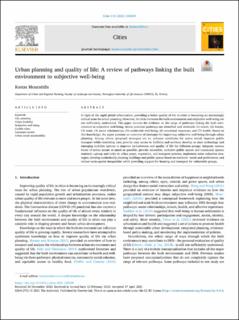| dc.description.abstract | In light of the rapid global urbanization, providing a better quality of life in cities is becoming an increasingly critical issue for urban planning. However, the links between the built environment and subjective well-being are not sufficiently understood. This paper reviews the evidence on the range of pathways linking the built environment to subjective well-being. Seven potential pathways are identified and reviewed: (1) travel, (2) leisure, (3) work, (4) social relationships, (5) residential well-being, (6) emotional responses, and (7) health. Based on this knowledge, the paper presents an overview of strategies for improving subjective well-being through urban planning. Among others, proposed strategies are to: enhance conditions for active travel; improve public transport while restricting cars; provide easy access to facilities and services; develop or steer technology and emerging mobility options to improve inclusiveness and quality of life for different groups; integrate various forms of urban nature as much as possible; provide accessible, inclusive public spaces and communal spaces; maintain upkeep and order in urban space, vegetation, and transport systems; implement noise reduction strategies; develop aesthetically pleasing buildings and public spaces based on residents' needs and preferences; and reduce socio-spatial inequalities while providing support for housing and transport for vulnerable groups. | |
